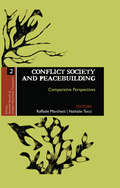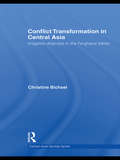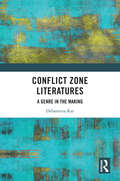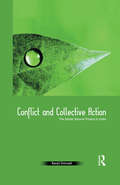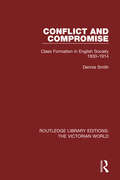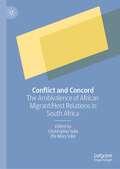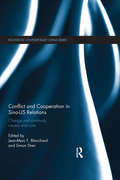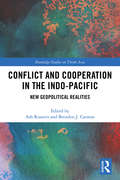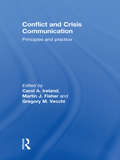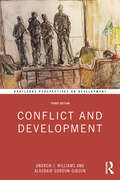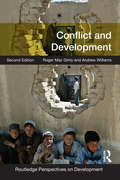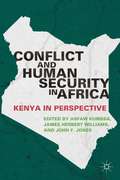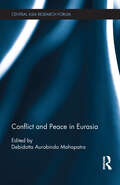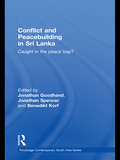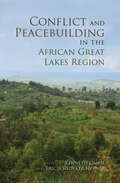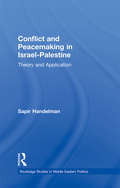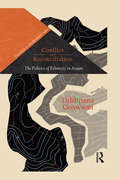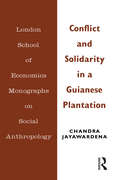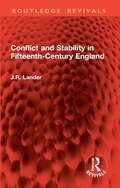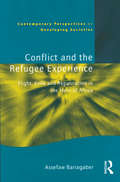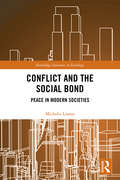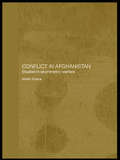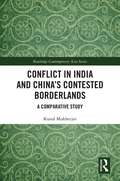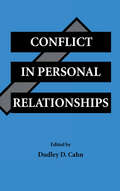- Table View
- List View
Conflict Society and Peacebuilding: Comparative Perspectives (Ethics, Human Rights And Global Political Thought Ser.)
by Raffaele MarchettiCivil society’s role in conflict and peace-building is increasingly being recognized: an integral element in conflict, it can act within the conflict dynamic to fuel discord further or to entrench the status quo. Alternatively, it can bring about peaceful resolution and reconciliation. The question at hand is not whether to engage civil society in contexts of conflict, but rather how governmental actors can partner with civil society to induce conflict resolution and conflict transformation. The collection of essays in this volume attempts to explore this nexus between civil society and peace-building, especially in the context of intra-state and identity-driven conflicts, across different regions by focusing on case studies from Asia, Africa, Latin America and Europe.
Conflict Transformation in Central Asia: Irrigation disputes in the Ferghana Valley (Central Asian Studies)
by Christine BichselThis book provides the first systematic analysis of peace-building in Central Asia for inter-ethnic conflicts over water and land in the Ferghana Valley based on concrete, in-depth and on-site investigation. The core analysis centres on peace-building projects in Kyrgyzstan, Uzbekistan and Tajikistan by three international aid agencies –an international NGO, a bilateral governmental donor and a multilateral agency – and the shared approach which the donors developed and used for conflict transformation. Using ethnographic case material, the author critically examines both the theoretical assumptions guiding this approach and its empirical outcomes when put into practice. Building on existing work in conflict transformation and the ethnography of international assistance in Central Asia, the book sheds light on Western attempts to transform the post-socialist societies of Central Asia and provides fresh empirical data on and insights into irrigation practices, social institutions, and state and identity formation in the Ferghana Valley. The book provides a novel and innovative approach to the study of development assistance and peace-building. It will be of interest to researchers in the field of Central Asian Studies, post-Soviet Studies, Development and Peace and Conflict Studies.
Conflict Zone Literatures: A Genre in the Making
by Debamitra KarThis book examines the metanarratives promoted by the state that determine the ideological framework and how these respond under extraneous circumstances like conflicts. The volume shows how individuals in such geo-politically aggrieved zones re-organise, re-structure and re-interpret their memory and identity and negotiate with violence in the literary space. Focusing on Kashmir and Northern Ireland in the decades of 1980s and 1990s, and post 9/11 America, the author maps the changing contours of the state and its powers in the late capitalist phase. It investigates complex themes such as the changing nature of governance and warfare, citizenship and resistance, inclusivity and xenophobia, and statecraft as a linguistic discourse in the post-global scenario.Interdisciplinary in approach, the volume will be of great interest to scholars and researchers of literature and aesthetics, peace and conflict studies, politics and international relations.
Conflict and Collective Action: The Sardar Sarovar Project in India
by Ranjit DwivediFor over two decades, large infrastructure development projects have been the subject of major controversies the world over. This book is a comprehensive account of the well-known Sardar Sarovar Project in India and the world-wide campaign against it led by the Narmada Bachao Andolan.The book attempts to understand the unfurling crisis around the Project in order to develop a comprehensive sociology of development action that goes beyond positivist methods and evaluative frames. It deals with three main research concerns: first, the theoretical focus on actually existing development; second, a methodological query concerning critical analysis; and third, the substantive examination of the NBA and its collective action against displacement in the Narmada Valley. Published posthumously, the book ends with the Supreme Court judgement on the Sardar Sarovar Dam. Amita Baviskar, well-known expert in the field, brings the debate up to the present in the
Conflict and Complexity: Countering Terrorism, Insurgency, Ethnic and Regional Violence (Understanding Complex Systems)
by Philip Vos Fellman Yaneer Bar-Yam Ali A. MinaiThis book follows the methodologies of complex adaptive systems research in their application to addressing the problems of terrorism, specifically terrorist networks, their structure and various methods of mapping and interdicting them as well as exploring the complex landscape of network-centric and irregular warfare. A variety of new models and approaches are presented here, including Dynamic Network Analysis, DIME/PMESII models, percolation models and emergent models of insurgency. In addition, the analysis is informed by practical experience, with analytical and policy guidance from authors who have served within the U. S. Department of Defense, the British Ministry of Defence as well as those who have served in a civilian capacity as advisors on terrorism and counter-terrorism.
Conflict and Compromise: Class Formation in English Society 1830-1914 (Routledge Library Editions: The Victorian World #44)
by Dennis SmithFirst published in 1982, this study explores the dynamics of class formation during the vital decades between 1830 and 1914, when a rising urban industrial order was developing in complex interdependence with a declining rural agrarian order. The book follows the divergent paths of two cities - Birmingham and Sheffield – in their social development. These paths reflect the complex process of conflict and compromise as the ‘old’ order was gradually replaced by the ‘new’. It studies in detail many aspects of social life that were affected by these changes such as education, public administration, political structures, public administration, religion, the professions, popular culture and family. This book will be of interest to those studying Victorian history and sociology.
Conflict and Concord: The Ambivalence of African Migrant/Host Relations in South Africa
by Christopher Isike Efe Mary IsikeThe book is a response to the dominant discourse of South Africa as unwelcoming to African immigrants. Acknowledging the reality of xenophobia against African migrants in South Africa, it explores the positive spaces of interactions between South Africans and African migrants that do not necessarily result in tension. Hence, the book is about conviviality, cohabitation, interdependency and the production of a multicultural rainbow nation. South Africa, its constitution and representation as a multicultural society is the perfect context to experiment with the ideas in the book. Part of the objectives is therefore to demonstrate, as contained in the title, the ambivalence of this relationship which the popular discourse of xenophobia has silenced.
Conflict and Cooperation in Sino-US Relations: Change and Continuity, Causes and Cures (Routledge Contemporary China Series)
by Jean-Marc F. Blanchard Simon ShenNumerous crosswinds are buffeting the more than 40-year-old People's Republic of China--American relationship, yet only once since Nixon’s historic trip to China in 1972 has a major conflagration seemed a real possibility. Anchoring the relationship throughout multiple storms are the two countries’ broad areas of collaboration such as deep links in culture, economics, and education. However, for some observers, the conflictual aspects of the relationship seem to be gaining prominence. Conflict and Cooperation in Sino-US Relations offers a timely and current look at one of the world’s weightiest bilateral relationships. It goes beyond detailing the conflict and cooperation that have been integral facets of China--US interactions since 1972, to gauging the relationship's evolution and future trends, examining its nuances regarding diverse issues such as the Asia-Pacific leadership structure, the South China Sea, and the Korean peninsula. The book further delves into the causes of conflict and cooperation, offers diverse solutions for tempering frictions between Beijing and Washington, and considers the efficacy of some of the mechanisms (e.g., military-to-military exchanges) that China and the US currently employ to manage their relationship.The chapters suggest that extreme anxieties about China--US relations may be misplaced, but that there nonetheless are some worrisome signs even in areas like economics and the environment that are perceived as naturally cooperative. While the book does not offer any silver bullets, various contributors contend that successful management of Sino-American relations may require greater American accommodation of China’s interests. This book will be of great interest to students and scholars of Chinese politics, American politics, international relations, and Asian studies, as well as to policy-makers working in the field.
Conflict and Cooperation in the Indo-Pacific: New Geopolitical Realities (Routledge Studies on Think Asia)
by Ash Rossiter Brendon J. CannonThis book explores the most important strategic questions about the emerging Indo-Pacific region by offering an incisive analysis on the current and future patterns of competition and cooperation of key nations in the region. Examining emerging policies of cooperation and conflict adopted by Indo-Pacific states in response to a rising China, the book offers insights into the evolving Indo-Pacific visions and strategies being developed in Japan, India, Australia and the US in reaction to shifting geopolitical realities. The book provides evidence of geopolitical advances in what some see as a spatially coherent maritime zone stretching from the eastern Pacific to the western Indian Ocean, including small island states and countries that line its littoral. It also analyzes the development and operationalization of Indo-Pacific policies and strategies of various key nations. Contributors provide both macro and micro perspectives to this critically significant topic, offering insights into the grand strategies of great powers as well as case studies ranging from the Philippines to the Maldives to Kenya. The book suggests that new rivalries, shifting alliances and economic ebbs and flows in the Indo-Pacific will generate new geopolitical realities and shape much else beyond in the twenty-first century. A timely contribution to the rapidly expanding policy and scholarly discussions about what is likely to be the defining region for international politics for coming generations, the book will be of interest to policymakers as well as students and academics in the fields of International Relations, Foreign Policy, Security Studies, Diplomacy and International Law, East and South Asian Studies, East African Studies, Middle East Studies, and Australian Studies.
Conflict and Crisis Communication: Principles and Practice
by Carol A. Ireland Martin J. Fisher Gregory M. VecchiConflict and crisis communication is the management of a critical incident which has the potential for resolution through successful negotiations. This can include negotiating with individuals in crisis, such as those threatening self-harm or taking individuals hostage as part of emotional expression, and also critical incidents such as kidnapping and terrorist activities. By focusing on the empirical and strong theoretical underpinnings of critical incident management, and including clear demonstrations of the practical application of conflict and crisis communication by experts in the field, this book proves to be a practical, comprehensive and up-to-date resource. Discussion of relevant past incidents – such as the 1993 WACO siege in the United States – is used to enhance learning, whilst an examination of the application of critical incident management to individuals with mental disorder offers groundbreaking insight from clinicians working in this area. Conflict and Crisis Communication is an excellent source of reference for national and international law enforcement agencies, professionals working in forensic settings, and also postgraduate students with an interest in forensic psychology and forensic mental health.
Conflict and Development (Routledge Perspectives on Development)
by Andrew J. Williams Alasdair Gordon-GibsonFully revised and updated in its third edition, this timely book brings together the study of conflict and war and the problems surrounding the economic development of developing societies that are most prone to experiencing problems in moving on after war.The book does so by reflecting on the issues surrounding war as it unfolds and after it has (in principle) ‘ended’, within the context of the history, present-day problems and future prospects. The book aims to highlight the possibilities, successes and failures of past and present policies that bring ‘development’ to countries and peoples that want to be more involved in deciding their own futures after conflict and war, and often find themselves subject to what can be seen as arbitrary and even alien ways of thinking and acting by institutions in which they theoretically have membership and agency but often do not in practice. The case studies have been fully updated to reflect changes and developments since the second edition of this text, and there are questions at the end of each chapter to promote reflection. This new edition presents a deeper dive into the history of conflict and the emergence of new theories and policy guidance about present and future options in the fields of conflict and development.Accessible and engaging, this textbook is a pivotal resource for a nexus of subjects related to the often separated fields of conflict and development studies, as well as practitioners in this area.
Conflict and Development (Routledge Perspectives on Development)
by Andrew Williams Roger Mac GintyIn the five years since the first edition of Conflict and Development was published the awareness of the relationship between conflicts and development has grown exponentially. Developmental factors can act as a trigger for violence, as well as for ending violence and for triggering post-conflict reconstruction. The book explores the complexity of the links between violent conflict (usually civil wars) and development, under-development and uneven development. The second edition incorporates significant changes in the field including the G7+ initiative, the New Deal on Fragile States, World Trade talks, major policy documents from the UNDP and World Bank and updates on the Afghanistan and Iraq wars.
Conflict and Human Security in Africa
by Asfaw Kumssa James Herbert Williams John F. JonesThis edited volume looks at human security and conflict in northern Kenya and nearby areas within Sudan, Somalia, Ethiopia, and Uganda. It spells out the precise meaning and nuances of human security in today's global economy and examines the causes and effects of conflict in the region within the context of human security.
Conflict and Peace in Eurasia (Central Asia Research Forum)
by Debidatta Aurobinda MahapatraFocusing on a range of Eurasian conflicts, including Nagorno-Karabakh, South Ossetia and Abkhazia, this book offers contemporary perspectives on the ongoing conflicts in the Eurasia, with an emphasis on the attempts towards peace. The book brings into focus how various factors such as ethnicity, religion, border disputes, resources, and animosities inherited from the past play crucial role in these conflicts. It questions whether developments in Eurasia affect other conflicts across the globe, and if differences between parties can be resolved without pulling the relations beyond adjustable limits. The book goes on to look at how tricky the path to peace would be, and furthers the development of a framework of study of Eurasian conflicts in the post-Soviet world, while taking into account both internal and external variables in analyzing these conflicts. It is a useful contribution to Central Asian and Caucasian Politics and Security Studies.
Conflict and Peacebuilding in Sri Lanka: Caught in the Peace Trap? (Routledge Contemporary South Asia Series)
by Jonathan GoodhandThe period between 2001 and 2006 saw the rise and fall of an internationally supported effort to bring a protracted violent conflict in Sri Lanka to a peaceful resolution. A ceasefire agreement, signed in February 2002, was followed by six rounds of peace talks, but growing political violence, disagreements over core issues and a fragmentation of the constituencies of the key parties led to an eventual breakdown. In the wake of the failed peace process a new government pursued a highly effective ‘war for peace’ leading to the military defeat of the LTTE on the battlefields of the north east in May 2009. This book brings together a unique range of perspectives on this problematic and ultimately unsuccessful peace process. The contributions are based upon extensive field research and written by leading Sri Lankan and international researchers and practitioners. The framework of ‘liberal peacebuilding’ provides an analytical starting point for exploring the complex and unpredictable interactions between international and domestic players during the war-peace-war period. The lessons drawn from the Sri Lankan case have important implications in the context of wider debates on the ‘liberal peace’ and post conflict peacebuilding – particularly as these debates have largely been shaped by the ‘high profile’ cases such as Kosovo, Afghanistan and Iraq. This book is of interest not only to Sri Lanka specialists but also to the wider policy/practitioner audience, and is a useful contribution to South Asian studies.
Conflict and Peacebuilding in the African Great Lakes Region
by Kenneth Omeje Tricia Redeker HepnerDriven by genocide, civil war, political instabilities, ethnic and pastoral hostilities, the African Great Lakes Region, primarily Uganda, Rwanda, Democratic Republic of the Congo, and Burundi, has been overwhelmingly defined by conflict. Kenneth Omeje, Tricia Redeker Hepner, and an international group of scholars, many from the Great Lakes region, focus on the interlocking conflicts and efforts toward peace in this multidisciplinary volume. These essays present a range of debates and perspectives on the history and politics of conflict, highlighting the complex internal and external sources of both persistent tension and creative peacebuilding. Taken together, the essays illustrate that no single perspective or approach can adequately capture the dynamics of conflict or offer successful strategies for sustainable peace in the region.
Conflict and Peacemaking in Israel-Palestine: Theory and Application (Routledge Studies in Middle Eastern Politics)
by Sapir HandelmanThe Israeli-Palestinian struggle is considered to be one of the most entrenched conflicts in the world. Presenting and evaluating interactive models of peacemaking and the phenomenon of intractable conflict, the book takes an in-depth look into specific models for peacemaking and applies them to the situation in Israel/Palestine. The argument centers around the idea that a multifaceted approach to peacemaking has the greatest potential to transform an intractable conflict into a mutually beneficial social order. Encompassing theoretical background, comparative studies of conflict resolution processes in similar circumstances around the world and policy recommendations, the author presents four interactive models of peacemaking to suggest a comprehensive approach to peacemaking that attacks the conflict from various angles, directions and dimensions. Introducing general conditions that have the potential to transform a situation of destructive conflict into a more peaceful social order, Conflict and Peacemaking in Israel-Palestine adds a fresh perspective to the study of destructive social conflicts and should provoke critical discussion among students and scholars of peace and conflict studies, Middle Eastern politics, conflict resolution and management.
Conflict and Reconciliation: The Politics of Ethnicity in Assam (Transition in Northeastern India)
by Uddipana GoswamiDiverging from reductionist studies of Northeast India and its multifarious conflicts, this book presents an exclusive and intricate, empirical and theoretical study of Assam as a conflict zone. It traces the genesis and evolution of the ethnic and nationalistic politics in the state, and explores how this gave birth to nativist and militant movements. It further discusses how the State’s responses seem to have exacerbated rather than mitigated the conflict situation. The author proposes ethnic reconciliation as an effective way out of the current chaos, and finds the key in examining the relations between three communities (Axamiyā, Bodo and Koch) from Bodoland, the most violent region of Assam. She stresses upon the need to redefine ‘Axamiyā’, an issue of much discord in Assam’s ethnic politics since the modern-day formulation of the Axamiyā nation. The book will prove essential to scholars and students of peace and conflict studies, sociology, political science, and history, as also to policy-makers and those interested in Northeast India.
Conflict and Solidarity in a Guianese Plantation (LSE Monographs on Social Anthropology #Vol. 25)
by Chandra JayawardenaThis study concerns two communities of sugar plantation labourers, the descendants of indentured immigrants from India, who live in the county of Berbice, British Guiana. The study is focused on the analysis of social conflict: the factors that cause it, the forms it takes and its social consequences.
Conflict and Stability in Fifteenth-Century England (Routledge Revivals)
by J.R. LanderFirst published in 1969, Conflict and Stability in Fifteenth-Century England is a study of a much neglected and misinterpreted century of English history—the century of the Wars of the Roses which, the author shows, had only a comparatively small effect on English life. Other sections discuss the economic repercussions of the Black Death, the literature and architecture of the times, religion and Anglo-papal relations on the eve of the Reformation, and the gradual beginnings of Tudor government.
Conflict and the Refugee Experience: Flight, Exile, and Repatriation in the Horn of Africa (Contemporary Perspectives on Developing Societies)
by Assefaw BariagaberOne of the most serious threats to peace, security and the sovereignty of nations in the post-Cold War era is population migration. A particularly volatile form of this threat is the global refugee problem and nowhere is this issue more severe than in Africa. This book offers a comprehensive analysis of refugee experience in the Horn of Africa. It includes an examination of the dynamics of flight from the country of origin, settlement in exile and repatriation to the country of origin. Such an integrative approach sets this book apart from other studies and will serve as a reader for courses on ethno-national conflicts, migration, international politics, security and African politics.
Conflict and the Social Bond: Peace in Modern Societies (Routledge Advances in Sociology)
by Michalis LianosIs violent conflict inevitable? What is it in our social nature that makes us conduct wars, genocides and persecutions? The answer lies in how we are programmed to bond and form communities that demand loyalty in order to let us belong. The analysis in this book cuts through the social sciences in order to show the fundamentals of violent conflict. The book investigates conflict at the level of sociality. It reorganises existing theories of conflict under that perspective and brings them to bear upon the link between violence and togetherness. It introduces the key concept of closure to describe the conditions under which human groups start to perceive their position as similar and their reality as polarised. This is how normality starts breaking down and fault lines appear. Violent conflict is then analysed as a reaction that seeks change more rapidly than conditions seem to allow. Global comparative data from numerous studies – including M. Mousseau's works – are used to disentangle the factors that contribute to "democratic peace", that is, the fact that democratic societies do not go to war with each other. This inquiry reveals the new dimension of sociodiversity, which allows societies where individuality is strong to constantly produce alternatives and avoid closure. The book concludes with a coda on peace and sociodiversity which explains how contemporary societies can ensure durable peace and adequate social justice at the same time. Written in a clear and direct style, this volume will appeal to students, researchers and scholars with an interest in political sociology, anthropology, international relations, war studies, as well as conflict and peace studies.
Conflict in Afghanistan: Studies in Asymetric Warfare
by Martin EwansAsymmetric warfare, involving conflicts where smaller powers apply their strengths against the weaknesses of a more powerful opponent, has become a key modern concern since the September 11th attacks. Conflict in Afghanistan tackles this issue by examining the five wars Afghanistan has waged against foreign powers over the past two centuries, all of which have involved forms of asymmetric warfare. Incorporating contemporary documents and material from Soviet archives, the text analyzes each war’s antecedents, conduct, and consequences. Important questions are asked about the role of religious beliefs, fanaticism, diplomacy, governmental decision-making and military competence, issues that have great contemporary relevance. The book provides an illuminating commentary of Afghanistan’s wars and examines the relevance of these conflicts to the modern-day challenge of counter-insurgency and asymmetric warfare.
Conflict in India and China's Contested Borderlands: A Comparative Study (Routledge Contemporary Asia Series)
by Kunal MukherjeeFor a long time, India and China have been seen as the rising economic giants on the Asiatic mainland. Studies of the conflicts which have plagued the borderlands of India and China however have tended to only analyse individual case studies without attempting to compare and contrast the situation in these conflicts. This book compares and contrasts the situation in India’s disputed borderlands – Kashmir and the Indian north eastern states – with China’s contested borderlands – Xinjiang and Tibet. The book looks at the root causes of the conflict and how these conflicts have evolved and changed their character with the passage of time. Analysing how the countries have dealt with their territorial disputes from the 50’s till more recent times, the author shows to what extent these state policies have exacerbated the already strained situation. Using primary data collected primarily through interviews, from the people/inhabitants of these conflict zones, the book throws new light on the problem. This bottom up approach allows the people to speak and provides a different understanding of the nature of the conflict, which may very well be the way forward for long lasting peace. A comparative study of the conflicts in the contested borderlands of China and India, the book will be of interest to scholars studying Asian security studies and Asian Politics particularly and Defence and Security Studies more generally.
Conflict in Personal Relationships (Routledge Communication Series)
by Dudley D. CahnIn keeping with a broad conception of interpersonal conflict, this book is organized into two parts. The first focuses on conflict on different types of couple relationships -- homosexual, cross cultural, dating but violent, engaged, and married -- and group relationships -- student peers, parents and their young children, and adult children and their aging parents. The chapters not only review past research on conflict in some relationships, but also take a significant step forward in introducing a variety of other relationship types for future research on conflict. These chapters also offer evidence that conflict is experienced differently in different types of interpersonal relationships. The second part of this book describes basic underlying principles and programs for dealing with interpersonal conflicts. Chapters in this section discuss patterns of argument in everyday life, issues associated with competence in interpersonal conflict, and mediation as a form of intervention for resolution.
